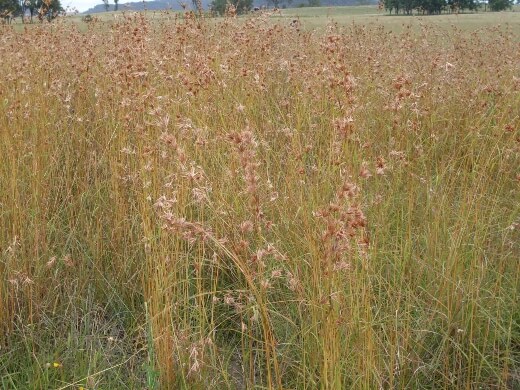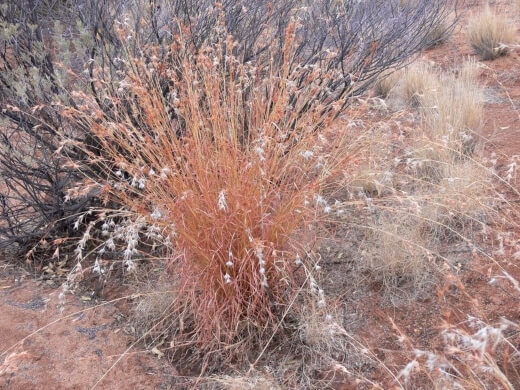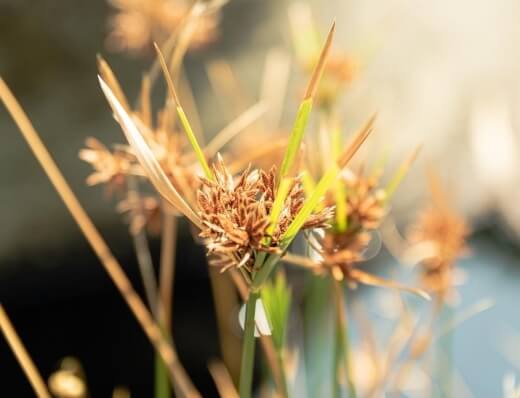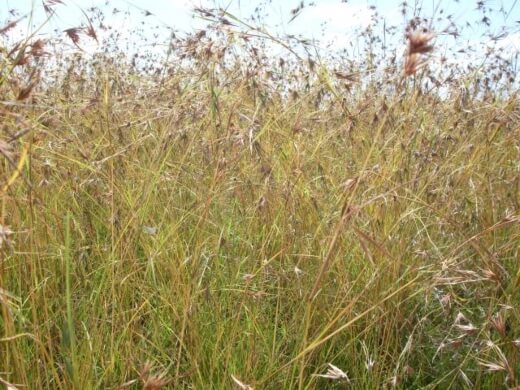As a gardener, you wouldn’t usually think of grass as ornamental, but kangaroo grass has a pretty charm about it. It rather looks like the kind of thing that children pick in a field, and make a wish on. You find kangaroo grass all over Australia, but it grows really well in New South Wales in particular.
In our how to grow and care guide, we’ll look at some info about this well-known native grass, how to propagate your own plant from seed or by dividing an existing plant, caring for your plant, and frequently asked questions.
More...
Family: | Poaceae |
|---|---|
Genus: | Themeda |
Species: | T. triandra |
Common Names: | Rooigras, Kangaroo grass, Red grass, Red oat grass |
Plant type: | Grass |
Height: | Up to 1.5 metres |
Spread: | Up to half a metre |
Sunlight: | Full sun or partial shade |
Soil type: | Well-drained, chalky, clay, loamy, sandy |
Soil pH: | Acid, alkaline, neutral |
Maintenance level: | Low |
Introducing Kangaroo Grass

Source: tsammalex.clld.org
Kangaroo grass (Themeda triandra) is part of the grass family and is a plant you likely have seen a lot around Australia. Themeda triandra is sometimes used to refer to both the African and Asian species of the same name, and includes the Australian species of Themeda australis.
Internationally, this species grows in Africa, Asia and the Pacific, making itself at home in grassland and woodland.
Growing Habits of Themeda triandra
Size wise, this species grows to about 1.5 metres in height and about half a metre in width. The leaves can be up to 50cm in length and are green grey and more of a brown colour in summer.
The grass produces flower spikes in a reddish brown colour and these can grow to 1.5 metres. The grass is attractive so it makes an interesting addition to any garden.
An obvious question is probably also, do kangaroos actually eat kangaroo grass? We do know that kangaroos enjoy eating lawns as grass is their preferred meal.
Kangaroo grass is grazed by a variety of different animals and is a source of food for kangaroos too.
Growing Kangaroo Grass in Australia
You’ll need to grow this plant in full sun or partial shade. In terms of soil, kangaroo grass is not too fussy and can do anything from sandy to clay.

Source: nativeshop.com.au
Best Soil for Red Grass
Kangaroo grass really isn’t particular about soil – good news for you! They can do dry soil to medium draining soil, but if they had to choose, a sandy loam or clay loam soil would be their first choice. Sandy soil along the coast for example is a good option.
Sunlight Requirements
Weeds move over! Kangaroo grass knows how to cut out light for other competing plants with its own shade. It will find its light with persistence but it does best in full sun. Partial shade is also an option if full sun isn’t possible.
Climate
Climate doesn’t present a challenge for kangaroo grass. As we’ve learned, they are quite resilient. This means that most climates are good for growing. Again, the first choice is subtropical and warm, but cool temperatures and even a light frost don’t phase them.


Get Your Free Guide:
Master Growing Australian Natives eBook
A Must Have Complete Guide for Every Australian Garden
Get Your Free Guide:
Master Growing Australian Natives eBook
A Must Have Complete Guide for Every Australian Garden
Themeda triandra Propagation
Once the plant has matured, you don’t need to water it much. If you’re looking to grow your own, you can use seed or you can divide clumps from a mature plant.

Source: exploroz.com
Kangaroo Grass Propagation by Seed
The best time to plant your seeds is from the beginning of spring to the middle of summer. You’re looking for a temperature of at least 20 degrees Celsius to help germination.
You want to choose seeds that are just starting to turn from green to brown. Sprinkle the seeds over a potting mix and as humidity changes, the seeds end up being pushed into the potting mix.
You want the seeds to be just under the soil so that it gets enough moisture. Without this, germination will be affected. You can add a 1cm layer of something like straw which helps the soil keep its moisture.
Too much mulch on the other hand will actually stop germination from happening. It’s a good idea to loosen up the soil a bit to get some air before planting.
Water your seedlings once a day for 6 weeks. It’s possible for some seeds to grow shoots in a few days, but 1 to 2 weeks is a good estimate. If nothing happens within a month, that seed probably won’t be able to sprout.
You can add a native slow release fertiliser to help the seed along and by autumn, you should be ready to transplant the shoots into the garden. Keeping the area for planting free from weeds is a must.
Propagating Red Oat Grass by Division of Clumps
For this method, you’re going to dig up the plant, divide it, and then plant it again. You need to be careful not to damage the plant’s root system in the process. A garden fork is more gentle than a spade when doing the dividing.
When you lift your plant from the ground, you can remove any dead leaves and old flowers at the same time. You should also cut the leaves left behind (by half) which protects the transplanted plant from shock after the division.
When dividing the root ball, you can even use a bread knife to help it along and then use your hands to gently pull apart. Aim for bigger pieces which improves their chance of surviving after being transplanted. You can then plant them directly into the garden.
How to Care for Kangaroo Grass
Once you’ve successfully propagated, now you need to know how to best care for it. Here are some guidelines to follow.

Source: geelongnativeplants.com.au
Watering Schedule
The water needs changes as the plant matures. In the seed stage, it’s vital to keep the soil moist to help the growing process along.
Once the grass is established, the plant is incredibly drought tolerant and barely needs any water during the summer months.
Pruning Red Oat Grass
Once your kangaroo grass is up and running, the plant is incredibly low maintenance. You can prune the grass once a year to get rid of any dead leaves and flowers, towards the end of summer.
This pruning process helps new growth and flowers for the following season. For the grassy leaves, if you want to improve the look of the plant, you can cut back the clumps at the beginning of spring which helps new green leaves to appear.
The right lawn tools can help to get the job done right. We love talking lawn tools, so if you’re looking for something, have a read through our articles where you can read everything from the best lawn aerators to the best lawn edgers today.
Fertiliser Needs
True to being low maintenance, kangaroo grass doesn’t need any fertiliser. If you do opt to give it a boost, something with a medium level of nitrogen would be helpful.
Possible Kangaroo Grass Pests and Diseases

The good news is that kangaroo grass is quite resistant to pests and disease. The only unwelcome visitor you might be dealing with is aphids. These tiny pests are sometimes impossible to see.
Different species of aphid are also different colours which also makes detecting them a little more tricky. If the leaves of your plant start to curl and yellow, you might be dealing with aphids.
Have a look on the bottom side of the leaf where they like to hide. You’ll sometimes notice a sticky goo which the aphids produce after snacking happily on your plant.
This liquid goo can cause another problem – sooty mould, which actually makes the plant look black. If you’ve discovered an aphid infestation, you can spray the plant with some strong water which can help to shake them loose.
You can use neem oil or an insecticidal soap to treat the affected parts of the plant, and can also wipe the leaves with water and dishwashing liquid. Follow this treatment every few days for about 2 weeks.
If you are dealing with sooty mould along with your aphids, you can clean the leaves in the same way you would to try and remove the aphids, and water actually dissolves the mould.
Kangaroo Grass Frequently Asked Questions

Source: feedipedia.org
What does the botanical name Themeda triandra mean?
Themeda comes from the Arabic word thaemed. It means a dam of sorts that gets filled with rainfall. Triandra is from the Greek words treis which means three, and aner which means man.
Kangaroo grass has different names in other parts of the world. What else is it called?
In East and South Africa, kangaroo grass is called red grass, red oat grass and rooigras.
What is kangaroo grass used for?
This plant is incredibly useful from a traditional perspective in both Africa and Australia where it has been used for food and medicinal properties. Kangaroo grass has been used to make fishing nets, and to feed animals.
Kangaroo grass is often used to prevent erosion of soil. In parts of Africa, it’s used to make thatch and baskets. You can also make paper pulp from the stems.
What kind of garden is kangaroo grass good for?
If you’re looking for low maintenance or living by the coast, this is a great plant to choose. It can be used as a ground cover or even a lawn alternative.
If I’m collecting kangaroo grass seed, how do I know if it will grow?
The seeds have a dormancy period of about 12 months. About 2/3 of the seed that you collect from one flower won’t be useful. A fertile seed is usually bigger than the infertile seeds.
Is Kangaroo Grass a protected species?
Kangaroo grass is not an endangered species but it does grow in some areas that are named as endangered in the Australian Capital Territory. Kangaroo grass is considered threatened in Victoria.
Does kangaroo grass have any food uses?
Kangaroo grass is used to make flour. Indigenous Australians used it to make porridge and nutty bread. It’s considered a healthy meal for horses as it minimises health problems.
The grass has less carbs so it prevents obesity and inflammation.
Is kangaroo grass resistant to fire?
This grass is fire retardant and actually grows better after being exposed to flame. Another Australian native which can also be used as a fire retardant is the Old Man Saltbush. Check out our complete growing guide here.
How does rain actually drive the seed into the ground?
The awns (the part that looks like a bristle) twists around and moves when it’s wet and this pushes the seeds into the soil.
What wildlife relies on kangaroo grass for food?
Butterflies like to eat the grass and they also use it to lay eggs. Birds including parrots also eat the seeds.
If you’re going to be having bird visitors to your garden, you might want to consider a bird bath. If they’re coming for something to eat when they enjoy the seeds of your kangaroo grass, they will likely need a drink of water too.
Looking for more gardening tips and advice? Sign up for our newsletter.
Wrapping Up Our Kangaroo Grass Guide
Kangaroo grass adds something special to a landscape, with its reddish colour, especially if you see it in the bush. Offset against a green background, it looks like a scene worthy of a painting (or many photos).
This beautiful grass is also hardy and water wise, so don’t be fooled by its softness and beauty. Growing kangaroo grass in your garden is a bit like bringing a bit of the adventure of the wild into your own garden.
You can challenge the conventions of the traditional lawn by growing kangaroo grass instead.
Published on July 28, 2022 by Lorri Hopkins
Last Updated on February 22, 2024




